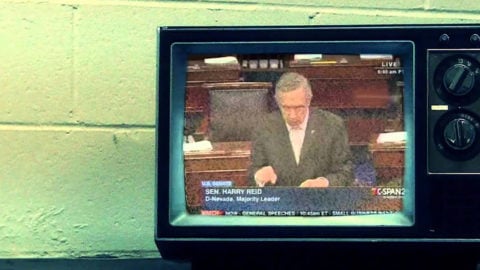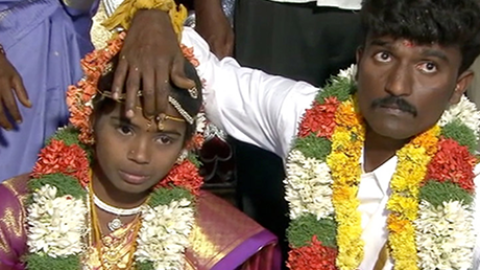Sundance: Our New President

In 1927, Esfir Shub was asked to commemorate the 10th anniversary of the Bolshevik Revolution with a movie. After World War I, film stock was scarce—for a while during Vladimir Lenin’s rule, every request for 100 meters of film (about 2 or 3 minutes) required his personal approval. Shub and other Soviet directors had limited resources, so she experimented with editing archival footage, and the result was The Fall of the Romanov Dynasty—generally viewed as the first found-footage film and the blueprint for so many Soviet and Russian filmmakers who would follow her, including Eisenstein, who theorized her work and brought those techniques into filmmakers’ consciousness globally.
Director Maxim Pozdorovkin (Pussy Riot: A Punk Prayer), who tells me this historical information over the phone, wrote a dissertation on Shub and the development of early Soviet/Russian cinema. With his new found-footage documentary, Our New President—originally made as a short for Field of Vision—Pozdorovkin is now also paying homage to Shub’s work: his film tells a thrilling, scary, mind-bending, and often-hilarious story of Russian propaganda’s role in the 2016 U.S. presidential election, constructed almost entirely of Russian newsreel footage, along with some very choice YouTube clips of Russian citizens enacting their comically severe distaste for Clinton and adoration for Trump.
“We wanted to see if it was possible to make a documentary out of news without a single true statement in it,” Pozdorovkin says. “The basic litmus test for what we would include was whether or not there was enough falsity in the claim in the clip, and we specifically looked at three Russian channels, where something like 87 percent of citizens receive their news—Russia 1, Russia Today, and NTV, the former independent channel that now also follows the party line.”

The clips are often ghastly, damning, and flagrant in their admissions and claims—many of them openly proclaiming the Russians were meddling in the election to help Trump. (Many of these have since been scrubbed from the Internet.) In one segment of clips, we see multiple news stations picking up and recycling the manufactured story of Clinton’s deadly illness after she collapsed from pneumonia at a 9/11 ceremony. We don’t have to see Fox News running with the conjectures—we already know. Viewing these clips flash so quickly in succession, it is as though we are witnessing a sophisticated disinformation campaign unfold before our eyes; this is, at some level, the origin story of our own election news nightmare. Pozdorovkin’s and Matvey Kulakov’s editing allows for the clips to be almost in dialogue with each other, taking the claim made in the first, adjusting it a little and regurgitating it with a slightly altered and more alarming message of Clinton’s health, like a lethal game of Telephone, where world politics hangs in the balance.
Pozdorovkin was inspired by so many other Russian filmmakers for the construction of this film, including Dziga Vertov (Man with a Movie Camera) and Mikhail Romm (Ordinary Fascism), but many of his more recent inspirations come from the United States. Ken Jacobs’s seven-hour experimental documentary Star Spangled to Death is an assemblage of American-grown propaganda, including blatant racism expressed in film or news, presidential speeches, and even archival educational videos aimed at African-Americans in an effort to get them to assimilate into society. “All of these deconstruct the authoritarian language of newsreel and media by finding cracks in it,” Pozdorovkin says.
The director also cites the 2015 Gary Shteyngart New York Times Magazine article, “Out of My Mouth Comes Unimpeachable Manly Truth” as a theoretical cousin of Our New President. For that piece, Shteyngart holed up in a hotel room for a week with five televisions all tuned to Russian news channels to see how it would shape his mind. Ultimately, Pozdorovkin’s film is asking its viewers the same questions: after being immersed in absurdity, can you really tell truth from fiction, and wouldn’t it perhaps be easier to throw your hands up and simply submit? What happens when the news is more bizarre than fiction?

In the film’s opening five-minute sequence, a bizarre series of clips from the 1990s portrays Hillary Clinton receiving a curse from a mummified Russian princess. The footage is disorienting and feels almost as though you’re trapped in a thriller or adventure film. In our interview, Pozdorovkin equates that segment to something John Carpenter might create. Later in Our New President, this footage is recycled by contemporary news programs citing the return of the curse, and Pozdorovkin is, in turn, editing that footage of edited footage into a documentary ultimately commenting on propagandistic editing. It may hurt your brain to think about it.
The director laughs as he calls the film “a 78-minute lobotomy.” He says Our New President differs from other Russia/Trump-centric films made this past year, because he refuses to goad outrage with an authoritative tone and talking heads telling you why something is wrong. “It’s more effective to have something horrifying and hilarious side by side, because I think that it’s harder to have that stable position of finger wagging—you feel yourself more implicated.”
Pozdorovkin stresses that Russian cinema stems from its focus on postproduction—the recycling of footage. How the Russian news media now operates, editing and re-editing clips to manipulate reality, is an extension of that tradition. But fortunately there are also filmmakers like Pozdorovkin who apply Shub’s innovative techniques to expose the distortions of propaganda and their miserable real-world effects.
Our New President premieres January 18 at the Egyptian and screens again January 19, 20, 25, and 26.






